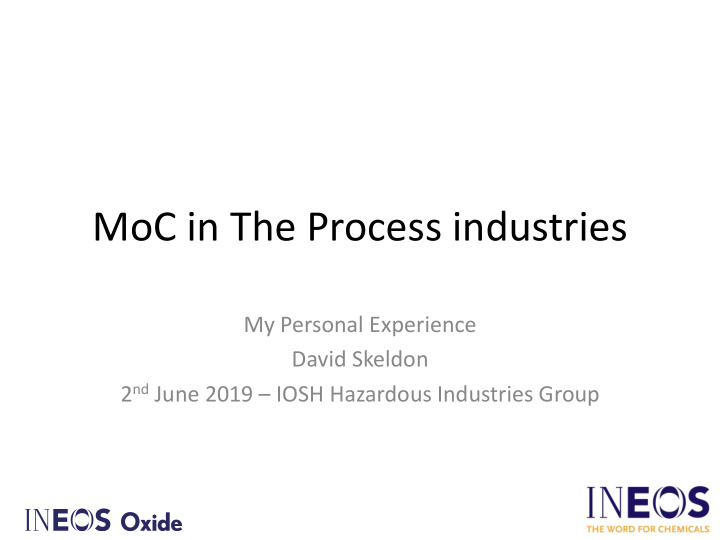



MoC in The Process industries My Personal Experience David Skeldon 2 nd June 2019 – IOSH Hazardous Industries Group
Agenda • Introduction and History • How have MoC systems evolved? • Themes and Learning – Identifying Scope and Impact – Considering Detail • Summary
Introduction and History • Graduated Nottingham 1995 (Chemical Engineering) – Internship - International Paints • Hickson and Welch (1995- 2000) • BP Chemicals (2000-2008) • Ineos ( 2008-Present ) – Operations Engineer – Senior Process Engineer – Acetyls Process Technology Manager
Now Have MoC Systems Evolved? • Technical – Plant, Process, Materials • Organisational – Re- organisations, Staff changes, T&C’s, Locations, Ownership • Procedural – SOP’s, Technical Standards • What about a implementation of a change to a corporate standard?
Themes and Learning • Identifying Scope and Impact • Theoretical Example: – Re-trim of a control valve – 10% increase in maximum flow Issues: • Line size/Valve size • Design Pressure and temperature • Support arrangements • Control Valve Tuning
Scope and Impact Issues: • Line size/Valve size • Steam Design Pressure and temperature • Support arrangements • Control Valve Tuning • Heat exchanger Condensate design/capacity • Exchanger design temperature and pressure • Condensate system sizing
Scope and Impact Issues: • Line size/Valve size • Design Pressure and temperature • Support arrangements • Control Valve Tuning • Heat exchanger design/capacity • Exchanger design temperature and pressure • Condensate system sizing • Column Sizing • Column Operating Envelope
Scope and Impact Issues: • Line size/Valve size • Design Pressure and temperature • Support arrangements • Control Valve Tuning • Heat exchanger design/capacity • Exchanger design temperature and pressure • Condensate system sizing • Column Sizing • Column Operating Envelope • Condenser sizing • Safety Valve Sizing • Flare system capacity
Scope and Impact • Real Example: – Large scale continuous plant – Requirement for two polymerisation inhibitors • Process – high temperatures, short residence time • Bulk Storage – ambient, long residence time – Change to the process inhibitor used • Less toxic • Less manual handling • More Effective at process conditions • Cheaper (a lot!)
Scope and Impact • Management of Change Process – Laboratory studies (at process conditions) – MoC Form – Detailed Health and Safety Assessment (Team Exersize) – Documentation Updates • Operating Procedures • COSHH Assessments • Analysis requirements – Physical Changes to the unit
Scope and Impact • What Happened? – Rapid polymerisation event in offsite off specification storage tank – Emergency vent lifted – Emission to atmosphere – Tank irreparably damaged
Scope and Impact • Why? – Focus on core production unit only – Effect on Offsite off specification tank missed – Procedures/analysis for this unit not updated – Fall in inhibitor levels missed
Themes and learning • Considering Detail • Background – Frequent blocking of pump suction strainer – Conventional single basket strainer – Replaced with multi basket strainer (Standard vendor supplied equipment) • Less frequent strainer cleans • Improved manual handing • Easier preparation (Draining/flushing etc.)
Considering Detail • Management of Change – Full MoC process with sign off – Detailed HSE review (Team exercise) – Many issues identified – spares, leaks, training etc. – Identified that process technicians had “ mechflex ” training and so were ok to open, clean out and box up filter – Procedures updated, training delivered
Considering Detail • What Happened – Filter passed pressure test prior to start up – During start up one stud came loose – Significant loss of Acetic acid (100mm opening) – Contained within unit drainage system – No Injuries – incredibly fortunate – Isolated quickly
Considering Detail • Why? – Mech flex training covered bolting up of flanges but did not consider ‘captive’ studs – Studs needed to be fully screwed into the filter body – Filter lids were held in place with two studs each. Four filter lids per filter unit – One stud was not fully screwed in
Considering Detail
Summary • Two key questions: – Does the MoC consider all of the upstream and downstream impacts? What about outside battery limits? – Does the MoC consider sufficient detail? • Equally applicable to organisational or procedural change • Questions?
Recommend
More recommend